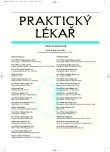Hyperhomocysteinemia and ischemic stroke
Hyperhomocysteinémia a ischemická cievna mozgová príhoda
Ateroskleróza je multifaktoriálne ochorenie hromadného výskytu, ktorého cievnoorgánové komplikácie sú najčastejšou príčinou úmrtnosti vo vyspelých krajinách. V súčasnosti je známy celý rad rizikových faktorov, ktoré vedú ku vzniku alebo urýchleniu progresie aterosklerotických zmien. Jedným z faktorov, ktorý zvyšuje riziko vzniku aterosklerózy nezávisle na zmenách lipidového metabolizmu, je zvýšenie plazmatických koncentrácii homocysteínu. Hyperhomocysteinémia je v súčastnej dobe považovaná za nezávislý rizikový faktor pre vznik kardiovaskulárnych ochorení. Epidemiologické štúdie posledných rokov poukazujú, že zvýšenie koncentrácie plazmatického homocysteínu predstavuje aj nezávislý rizikový faktor ischemických mozgových príhod. Asociácia zvýšenej hladiny homocysteínu s konvenčnými rizikovými faktormi aterosklerózy významne zvyšuje kardiovaskulárnu morbiditu a mortalitu. Vitamínovou substitúciou kyseliny listovej, vitamínmi B6 a B12 sa dá hladina homocysteínu znížiť.
Kľúčové slova:
homocysteín, hyperhomocysteinémia, cievna mozgová príhoda, primárna a sekundárna prevencia
Authors:
Youcef A..
Authors‘ workplace:
Slovenská republika.
; Prednosta: Prof. MUDr. Andrej Dukát, CSc, FESC.
; II. Interná klinika FNsP, Mickiewicova 13, Bratislava
Published in:
Prakt. Lék. 2006; 86(12): 683-686
Category:
Various Specialization
Overview
Atherosclerosis is a widespread multifactorial disease. Its complications represent the most frequent cause of death in developed countries. Nowadays we know many risk factors which may lead to a rapid progression of atherosclerosis. Hyperhomocysteinemia is one of these factors which is not related to lipid metabolism. Many recent epidemiological studies have suggested that a high blood level of homocysteine is an independent risk factor for ischemic stroke. The coincidence of hyperhomocysteinémia and other risk factors of atherosclerosis significantly increases morbidity and mortality. Substitutional therapy with folic acid, vitamin B6 and B12 decreases the blood level of homocysteine.
Key words:
homocysteine, hyperhomocysteinemia, cerebral stroke, primary and secondary prevention
Labels
General practitioner for children and adolescents General practitioner for adultsArticle was published in
General Practitioner

2006 Issue 12
- Memantine Eases Daily Life for Patients and Caregivers
- Metamizole vs. Tramadol in Postoperative Analgesia
- Metamizole at a Glance and in Practice – Effective Non-Opioid Analgesic for All Ages
- Memantine in Dementia Therapy – Current Findings and Possible Future Applications
- What Effect Can Be Expected from Limosilactobacillus reuteri in Mucositis and Peri-Implantitis?
Most read in this issue
- Severe lactic acidosis associated with acute renal failure in a diabetic patient treated with metformin – A case study.
- Role of coronary calcium scoring in a spectrum of examination procedures
- Restoration of hand movement following irreparable radial nerve palsy
- Neurosyphilis
